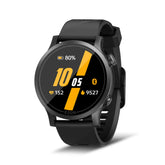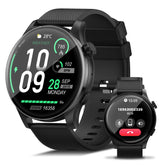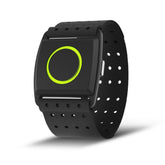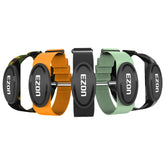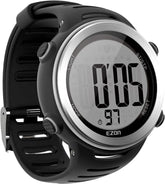Stress-Free Fitness: How Sports Watches Boost Mental Health Through Exercise
In a fast-paced world, fitness isn’t just about physical health—it’s a sanctuary for the mind. Stress tracking watches and HRV data offer science-backed tools to turn exercise into stress relief, while activities like group cycling and hiking foster community and calm. This guide reveals how to leverage technology and movement for holistic mental health.
1. The Exercise-Stress Connection: Why Movement Heals
A. The Neurochemical Boost
- Endorphins & Dopamine: 30 minutes of moderate exercise releases “feel-good” hormones, reducing anxiety by 25% (Harvard Health Study).
- Cortisol Regulation: Steady activity lowers stress hormone levels—HRV data reflects this through improved heart rate variability.
B. HRV: Your Body’s Stress Thermometer
- High HRV (60+): Indicates resilience to stress—ideal for intense workouts (e.g., HIIT).
- Low HRV (<40): Signals burnout risk—prioritize gentle activities like yoga or hiking.
- Watch Insight: Use EZON’s HRV scoring to tailor daily intensity (e.g., low HRV = easy walk; high HRV = group cycling).
2. Group Cycling: Pedal Away Stress in Community
A. The Social Buffer Effect
- Shared Effort: Group rides create camaraderie, reducing perceived stress by 40% (Journal of Sport & Exercise Psychology).
- Paced Intensity: Follow your watch’s stress score to maintain Zone 2–3 (60–80% MHR), balancing exertion with conversation.
B. Route Therapy
- Scenic Routes: Plan rides through parks or trails—natural environments lower cortisol by 15% (University of Michigan research).
- Watch Feature: Use GPS to discover new cycling paths, triggering a sense of adventure and novelty.
3. Hiking: Nature + Movement = Mental Clarity
A. Forest Bathing (Shinrin-Yoku)
- Immersion in Nature: 2 hours of hiking reduces anxiety and rumination, with HRV data showing improved recovery post-outing.
- Trail Pacing: Use your watch’s elevation alerts to adjust effort on climbs (e.g., Zone 3 on ascents, Zone 2 on flats).
B. Mindful Movement
- Step Count Mindfulness: Focus on steady, deliberate steps (100–120 steps/min) to anchor attention in the present moment.
- Group Hiking: Share the trail with friends—social interaction amplifies the mood-boosting effects of exercise.
4. Sports Watches: Your 24/7 Stress Management Coaches
A. Real-Time Stress Scoring
- On-Demand Readings: Press a button to get a stress score (1–100) based on heart rate and breathing—score >70 = take a 5-minute pause.
- Guided Breathing: Use watch-led 4-7-8 breathing exercises to lower heart rate by 5–10 BPM in minutes.
B. Recovery Tracking for Mental Resilience
- Sleep Staging: Ensure 15–20% deep sleep for emotional regulation—use watch insights to adjust bedtime (e.g., 10 PM lights-out for 7 hours).
- Active Recovery Alerts: Schedule 30-minute walks when watch detects high stress (e.g., “Take a break—your HRV is low”).
C. Social Challenges for Motivation
- Step Challenges: Compete friendly with friends to hit 10,000 steps/day—research shows social accountability increases adherence by 65%.
- Virtual Group Rides: Join online cycling clubs via watch apps, fostering connection even in solo workouts.
5. Build Your Stress-Free Fitness Routine
A. Weekly Plan Based on HRV
High Stress Days (HRV <40)
- Activity: 45-minute hike at Zone 2 + 10-minute guided breathing (watch-led).
- Goal: Lower stress score from 80 to 60 by day’s end.
Medium Stress Days (HRV 40–60)
- Activity: 30-minute group cycling + 15-minute core work.
- HRV Focus: Maintain steady effort to keep stress score between 50–60.
Low Stress Days (HRV >60)
- Activity: HIIT or competitive cycling class at Zone 4–5.
- Reward: Celebrate with a post-workout social hike.
B. Pre-Workout Stress Ritual
- 5-Minute Prep: Check stress score; if >70, do dynamic stretches while focusing on breath—aim for score <65 before starting.
6. Gear for Mind-Body Balance
A. Stress Tracking Watch Features
| Feature | Mental Health Benefit | EZON Recommendation |
|---|---|---|
| Stress Score | Real-time anxiety feedback | EZON Stress & Recovery Watch |
| Nature Sound Alerts | Trigger calm with forest/sea sounds | EZON Wellness Series |
| Social Sharing | Post workouts to boost motivation | EZON GPS Series with App Integration |
B. Comfort Accessories
- Wireless Headphones: Play nature sounds or guided meditations during solo hikes.
- Ergonomic Bike Seat: Reduce physical discomfort to enhance mental focus on group rides.
7. Common Mistakes to Avoid
-
Overtraining to “Escape” Stress:
- Solution: Use HRV to avoid pushing too hard—low HRV means prioritize rest over intensity.
-
Ignoring Intuition for Data:
- Solution: Balance watch insights with how you feel—if tired, scale back even with high HRV.
-
Isolating During Workouts:
- Solution: Join at least 1 group activity weekly to reap social stress-relief benefits.
8. FAQs: Your Stress-Relief Questions Answered
Q: Can exercise increase stress if done wrong?
- Yes! Overtraining raises cortisol. Use HRV and stress scores to stay in “productive stress” zones (e.g., Zone 2–3 for most days).
Q: How soon do I feel the mental benefits?
- Most notice reduced anxiety within 10–15 minutes of movement; cumulative effects build after 2–4 weeks of consistency.
Q: Are there workouts to avoid when stressed?
- Avoid high-intensity solo workouts when stressed (e.g., solo HIIT). Opt for group activities or nature-based exercise instead.
Move Beyond Stress, Toward Balance
With stress tracking watches and intentional movement like group cycling and hiking, fitness becomes a proactive stress solution. Let HRV data guide your intensity, group connections fuel your motivation, and nature reset your mind.
Gear up with a watch that understands your mental health needs, and make every workout a step toward calm. Stress may be inevitable, but with the right tools and routines, you’ll turn pressure into purpose—one heartbeat, one pedal stroke, one trail step at a time.
EZON Watch: Professional sports technology brand
https://ezonwatch.com
https://ezonwatch.com
